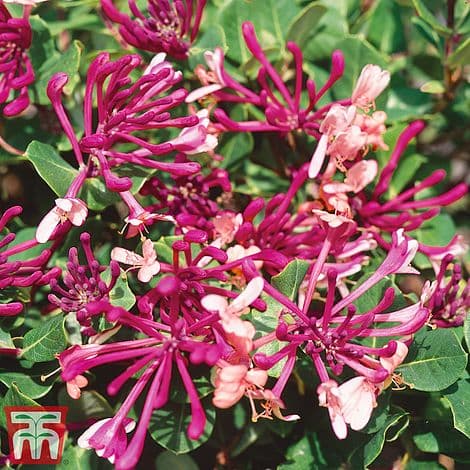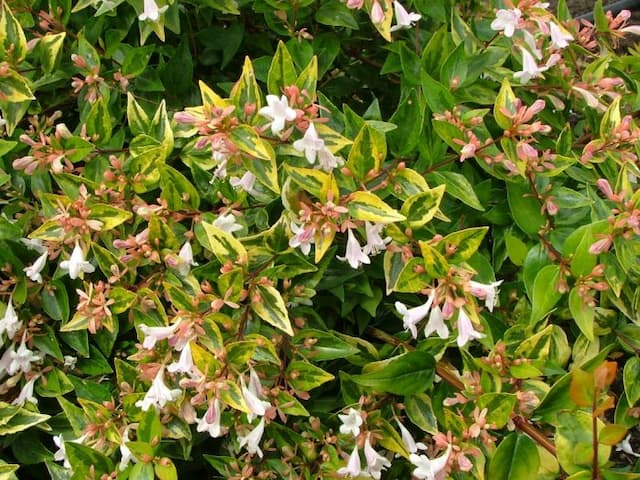Japanese Honeysuckle Lonicera japonica 'Dart's World'

ABOUT
The plant commonly known as Japanese honeysuckle, specifically the 'Dart's World' variety, is an attractive, vigorous twining vine known for its stunningly beautiful appearance. This plant showcases vibrant green leaves that may have a slightly bluish or purplish tinge when young, maturing to a deep green as they age. The leaves are oval-shaped and may be slightly elongated, with a tendency to grow opposite one another along the stem. Its most captivating feature is the profusion of flowers it produces. The blossoms present a striking contrast of colors. They typically open white and gradually turn to a deep pink or sometimes a reddish hue. The flowers are tubular, with a flare at the mouth, and emit a sweet, intoxicating fragrance that is strongest in the evening or at night. This delightful scent attracts pollinators such as butterflies and hummingbirds into the garden. As the season progresses, the Japanese honeysuckle may produce small black berries which stand out against the green foliage, adding further interest to the plant's overall appearance. These berries can be quite attractive to wildlife, although they are considered inedible for humans. Overall, 'Dart's World' is a plant that is cherished for its ornamental qualities and its ability to add a lush, romantic look to garden settings.
About this plant
 Names
NamesFamily
Caprifoliaceae.
Synonyms
Japanese Honeysuckle, Hall's Honeysuckle, Gold-and-Silver Flower, Chinese Honeysuckle, White and Yellow Honeysuckle.
Common names
Lonicera japonica 'Dart's World'.
 Toxicity
ToxicityTo humans
Japanese honeysuckle (Lonicera japonica 'Dart's World') is considered toxic if ingested in large quantities. While honeysuckle berries attract birds, the berries, stems, and leaves can be harmful to humans. Symptoms of poisoning from eating parts of the plant may include stomach upset, diarrhea, rapid heartbeat, and in severe cases, respiratory failure or convulsions.
To pets
Japanese honeysuckle is also toxic to pets. If dogs, cats, or other animals ingest parts of the plant, particularly in large amounts, they may experience symptoms similar to those in humans, such as gastrointestinal upset, diarrhea, and possibly more serious symptoms such as lethargy, difficulty in breathing, or even seizures. It is advised to prevent pets from consuming this plant to avoid these potential health risks.
 Characteristics
CharacteristicsLife cycle
Perennials
Foliage type
Semi-deciduous
Color of leaves
Green
Flower color
Mixed
Height
10 feet (3 meters)
Spread
6 feet (1.8 meters)
Plant type
Climber
Hardiness zones
4-9
Native area
Japan
Benefits
 General Benefits
General Benefits- Aesthetic Appeal: Lonicera japonica 'Dart's World', commonly known as Japanese honeysuckle, offers an abundance of attractive, tubular flowers that range from pink to deep red, making it a popular choice for ornamental purposes.
- Fragrance: The plant is well-known for its sweet and potent fragrance, which is most pronounced in the evening, making it an excellent choice for gardens where evening ambiance is a priority.
- Wildlife Attraction: Japanese honeysuckle attracts various pollinators, including bees and hummingbirds, which are essential for a healthy ecosystem.
- Growth Habit: It is a vigorous grower and can cover large areas quickly, which is ideal for gardeners wanting to establish ground cover or screening in a short period of time.
- Erosion Control: The plant's dense growth habit can help prevent soil erosion on slopes and banks.
- Adaptability: It is adaptable to a wide range of conditions, which allows it to thrive in various soil types, levels of sunlight, and moisture conditions.
- Low Maintenance: Once established, Japanese honeysuckle typically requires minimal care, making it an attractive option for gardeners who prefer low-maintenance landscapes.
- Seasonal Interest: The flowers bloom from late spring to early summer, providing seasonal interest and color to gardens during these times.
 Medical Properties
Medical Properties- Anti-inflammatory: Contains anti-inflammatory properties which may help reduce swelling and inflammation.
- Antibacterial: Exhibits antibacterial effects against certain strains of bacteria.
- Antiviral: May have antiviral activity, especially against influenza viruses.
- Antioxidant: Contains antioxidants that protect cells from oxidative damage.
- Soothing agent: Can be used to soothe sore throats and alleviate coughs.
 Air-purifying Qualities
Air-purifying QualitiesThis plant is not specifically known for air purifying qualities.
 Other Uses
Other Uses- Lonicera japonica 'Dart's World', commonly known as Japanese honeysuckle, can be used as a ground cover to prevent soil erosion on slopes due to its fast-growing and spreading nature.
- The plant's twining vines can be trained to grow over arbors or pergolas, offering a natural and fragrant shade during warm seasons.
- Japanese honeysuckle can be included in sensory gardens for its sweet fragrance, which is particularly strong in the evenings, thus enhancing the sensory experience.
- The flowers can be floated in water bowls indoors as a natural air freshener and an aesthetically pleasing decoration.
- When dried, the vines of the honeysuckle plant can be used in basket weaving and other crafts for their durability and flexibility.
- In landscaping, Japanese honeysuckle can be used to create privacy screens or living fences when trained on trellises or fence lines.
- As part of a wildlife garden, the plant can serve as a host for the larvae of certain butterfly species, contributing to native biodiversity.
- Japanese honeysuckle can be used in themed gardens, such as romantic or cottage gardens, for its old-fashioned, cascading flowers that evoke a bygone era.
- The vines can be used for decorative purposes in floral arrangements, providing both greenery and a pleasant scent.
- In large landscape areas, Japanese honeysuckle can be used to cover unsightly features, like piles of rocks or old tree stumps, blending them into the natural scenery.
Interesting Facts
 Feng Shui
Feng ShuiJapanese Honeysuckle is not used in Feng Shui practice.
 Zodiac Sign Compitability
Zodiac Sign CompitabilityJapanese Honeysuckle is not used in astrology practice.
 Plant Symbolism
Plant Symbolism- Devotion: Lonicera japonica, commonly known as Japanese honeysuckle, often symbolizes devoted affection and the bond of love, as the plant's vines grow closely intertwined.
- Fidelity: The tenacious and enduring nature of the honeysuckle's vines are emblematic of a strong and lasting relationship, symbolizing faithfulness in love and friendship.
- Generosity: With its abundant and sweet-smelling flowers, honeysuckle can represent the giving of joy and happiness to others, as well as the generous sharing of affections.
- Bonds of Love: The intertwining growth habit of the honeysuckle plant is often equated to the interconnectedness of lovers, highlighting the intertwining of lives and shared experiences.
- Happiness: The sweet fragrance and the pleasure it brings to the senses can symbolize the creation and enjoyment of happy moments.
 Water
WaterJapanese Honeysuckle 'Dart's World' prefers consistent moisture, so water when the top inch of soil feels dry. This usually equates to watering once a week, but may vary with climate conditions. Use around 1 gallon of water per plant each time you water, ensuring it seeps deep into the root zone. During hotter and drier periods, increase the frequency to twice a week. In winter, reduce watering as the plant's growth slows down.
 Light
LightJapanese Honeysuckle 'Dart's World' thrives in full sun to partial shade. The ideal location would offer morning sunlight and some afternoon shade, especially in hotter climates. Bright, indirect light will keep the plant healthy and promote vigorous growth and flowering.
 Temperature
TemperatureJapanese Honeysuckle 'Dart's World' can survive in temperatures as low as 20°F but prefers a range between 60°F and 80°F. It's crucial to avoid temperatures below 20°F to prevent damage to the plant. Ideally, maintain a temperate environment that doesn't regularly dip below freezing in winter or exceed the mid-80s°F during summer.
 Pruning
PruningPrune Japanese Honeysuckle 'Dart's World' to control growth, maintain shape, and encourage healthier, denser foliage. The best time for pruning is late winter or early spring before new growth begins. Cut back as much as one-third of the plant to promote vigorous new growth and to rejuvenate old plants.
 Cleaning
CleaningAs needed
 Soil
SoilJapanese Honeysuckle 'Dart's World' prefers well-draining, fertile soil with a pH between 5.5 and 7.5. A balanced mix can be achieved using two parts loam, one part peat moss, and one part compost or well-rotted manure to provide adequate nutrients and porosity.
 Repotting
RepottingJapanese Honeysuckle 'Dart's World' should be repotted every 2 to 3 years to prevent root bounding and to replenish nutrients in the soil. Best done in early spring before the growing season begins.
 Humidity & Misting
Humidity & MistingJapanese Honeysuckle 'Dart's World' thrives best in moderate humidity levels, typically between 40-60%. It can tolerate lower humidity but may need some protection from drying winds if grown outside.
 Suitable locations
Suitable locationsIndoor
Place in bright, indirect light with occasional pruning.
Outdoor
Plant in sun to partial shade, water regularly.
Hardiness zone
4-10 USDA
 Life cycle
Life cycleJapanese Honeysuckle 'Dart's World' begins its life cycle when seeds germinate in spring, given adequate moisture and warmth. The seedling stage follows, where the plant establishes a root system and begins to develop leaves. As it enters the vegetative stage, it produces vigorous stems and foliage, thriving particularly well in full sun to partial shade conditions. During the flowering stage, which occurs from late spring to frost, this twining vine produces fragrant flowers that transition from white to a pale yellow, attracting pollinators. After pollination, it enters the fruiting stage, bearing black berries that are dispersed by birds, enabling the proliferation of new plants. In winter or adverse conditions, Japanese Honeysuckle may go dormant, shedding its leaves, but it can still survive and regrow with the return of favorable conditions.
 Propogation
PropogationPropogation time
Spring-Early Summer
The Japanese Honeysuckle 'Dart's World' is typically propagated through semi-hardwood cuttings. The optimal time for taking cuttings is during the summer months, when the new growth has begun to mature but is not yet fully hardened. Cut a length of stem about 4 to 6 inches (10 to 15 centimeters) long, ensuring there are several sets of leaves at the top. Remove the leaves from the bottom half of the cutting. Then dip the cut end into a rooting hormone powder to encourage root development. The prepared cutting should then be placed in a pot filled with a mix of peat and perlite or sand, ensuring good drainage and aeration. Keep the soil moist but not soggy and maintain a warm environment. Roots typically develop within a few weeks, after which the new plants can be transplanted outdoors.

![Abelia [Sunshine Daydream]](/_next/image?url=https%3A%2F%2Fplants-admin.emdemapps.com%2Fimages%2Fplants%2F%2Fimages%2F604b61a1e9cdd.png&w=640&q=75)







